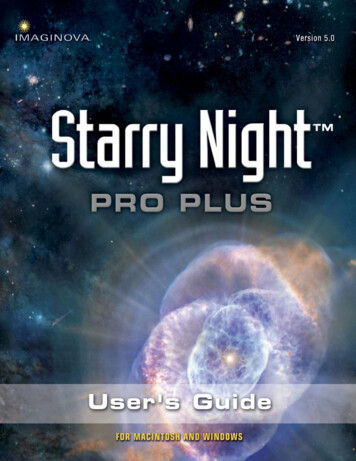
Transcription
Starry Night Companion Go to Table of Contents
BlankPage
Starry NightCompanion Your Guide to Understanding the Night SkyWritten by John MosleyEdited by Mike Parkesand Pedro BragancaForeword by Andrew L. Chaikin,acclaimed space and science author
CONTENTSForeword . . . . . . . . . . . . . . . . . . . . . . . . . . . . . . . . . . . . 7Introduction . . . . . . . . . . . . . . . . . . . . . . . . . . . . . . . . . . 9Section 1 – Astronomy Basics1.1 The Night Sky . . . . . . . . . . . . . . . . . . . . . . . . . . . . . 131.2 Motions of Earth . . . . . . . . . . . . . . . . . . . . . . . . . . . 231.3 The Solar System . . . . . . . . . . . . . . . . . . . . . . . . . . 29Section 2 – Observational Advice2.1 Skywatching . . . . . . . . . . . . . . . . . . . . . . . . . . . . . . 372.2 Co-ordinate Systems . . . . . . . . . . . . . . . . . . . . . . . . 45Section 3 – Earth’s Celestial Cycles3.1 Rotation . . . . . . . . . . . . . . . . . . . . . . . . . . . . . . . . . 553.2 Revolution . . . . . . . . . . . . . . . . . . . . . . . . . . . . . . . 633.3 Precession . . . . . . . . . . . . . . . . . . . . . . . . . . . . . . . 75Section 4 – Our Solar System4.1 The Moon . . . . . . . . . . . . . . . . . . . . . . . . . . . . . . . . 854.2 Planets, Asteroids & Comets . . . . . . . . . . . . . . . . . . 97Section 5 – Deep Space5.1 Stars and Galaxies . . . . . . . . . . . . . . . . . . . . . . . . . 1195.2 About the Constellations . . . . . . . . . . . . . . . . . . . . 1335.3 Highlights of the Constellations . . . . . . . . . . . . . . . 147Conclusion . . . . . . . . . . . . . . . . . . . .Appendix A – The Constellations . . . .Appendix B – Properties of the PlanetsGlossary . . . . . . . . . . . . . . . . . . . . .Index . . . . . . . . . . . . . . . . . . . . . . . .165167173175189
6Starry Night CompanionBlankPage
FOREWORDIf the sky could speak, it might tell us, “Pay attention.” That isusually good advice, but it’s especially valuable when it comes tothe heavens. The sky reminds us that things are not always as theyseem.It wasn’t too long ago that we humans believed Earth was thecenter of it all, that when we saw the Sun and stars parade acrossthe sky, we were witnessing the universe revolving around us. Ittook the work of some bold and observant scientists, including thePolish astronomer Nicolaus Copernicus, to show us how wrong wehad been: Instead of the center of the universe, Copernicus said,our world is one of many planets and moons circling the Sun in acelestial clockwork.Some 250 years later the Apollo 8 astronauts became the firsthumans to see the truth of this with their own eyes. As they madehistory’s first voyage around the Moon, they looked back at Earth,whose apparent size diminished until they could cover it with anoutstretched thumb. In that moment, they knew on a gut level that
8Starry Night CompanionCopernicus was right. Most of us, though, have not had the privilegeof such a view. Standing under a canopy of stars on a clear night,we’ve had to take on faith what astronomers have told us.The remarkable desktop planetarium, Starry Night changes allthat. Want to see why the Moon changes in appearance during amonth? Starry Night lets you “stand” on an imaginary vantage pointin deep space and see the Moon’s motion around Earth, watching asthe lunar nearside goes from darkness into sunlight and back again.Farther from home, you can watch Jupiter’s family of moonsrevolve like a solar system in miniature. You can ride on a comet asit makes its decades-long trek around the Sun. You can even journeyback in time, to see the sky as it looked when Galileo turned hisfirst telescope on the heavens. Or, you can peek into the future, toget an advance look at solar eclipses, lunar eclipses, and otherskyshows.A Starry Night Companion, then, offers a tour guide to theheavens. In the these pages, you’ll do something Copernicus couldonly dream of: You will learn your way around the universe. You’llcome to know it as a place filled with wonders, from red giant starsto glowing nebulae. You’ll experience what it would be like to viewthe sky from hundreds of light years away. And like the astronauts,you’ll return to Earth with a new perspective on our planet and itsplace in the cosmos.Best of all, you’ll enrich your experience of the wonders aboveour heads. The sky is there for us to enjoy, and that enjoyment isonly increased when we understand what we are seeing. When westand under a dome of stars, we can see it with the benefit of centuriesof detective work that have unraveled the heavens’ secrets. And wecan ponder the mysteries that remain for us to solve, if we only payattention.Andrew ChaikinAugust, 2000
INTRODUCTIONThe sky is enormous, distant, and filled with mysterious things.It doesn’t resemble anything we encounter in our daily lives. Thereis movement and change in the sky, but generally at a rate too slowfor us to notice. To many, the sky is intimidating. It may seeminaccessible. But it is superbly fascinating. You bought this bookand software package because you would like to get to know itbetter. Welcome – the adventure is about to begin.Two hard facts about the sky are that (1) changes in it happenslowly, and (2) we cannot cause it to change. We cannot turn it andlook at it from a different angle; we cannot speed up the rotation ofEarth or the motion of the planets through the constellations; wecannot cause an eclipse to happen; we cannot view the sky fromanother place on Earth (unless we actually go there); we cannot seewhat the sky looked like long ago or in the distant future. We arestuck in the here and now.That is the value of this book and software package. StarryNight lets you manipulate the sky. You can move backward and
10Starry Night Companionforward through time; you can move to any spot on Earth and toany planet; you can see imaginary lines in the sky (such as the pathsof the planets and constellation boundaries); you can discover futureevents and watch them before they actually happen, or replay famousevents from the past. As you go, you will gain a far better understanding of how the sky works than you can as a passive observer.Then, when you actually step outside on a clear night, you willhave a greater understanding of what you see. It will be fun. StarryNight lets you stargaze on cloudy nights and even during the daytime, but there is no substitute for stepping outside at night andseeing the real thing. Starry Night will help you appreciate whatyou see when you are outdoors on a starry night, but don’t forget toactually go outside and look up!How to Use This BookStarry Night Companion is organized into five sections.The first section covers the essentials of understanding the nightsky. The next four sections go into more detail.Section two will help you get the most out of your observing,no matter what you are looking at. It has observational tips, hintson choosing binoculars and telescopes, and a good description ofthe various astronomical co-ordinate systems.Section three covers the three different motions of Earth whichaccount for much of the variation we see in the sky.Section four looks at other objects in our solar system, includingour Moon and the nine planets.Finally, the fifth section takes you into the deep, describingstars, galaxies, and more.
Section 1Astronomy Basics
THIS SECTION ofStarry NightCompanion will give you aquick overview of thebasics of astronomy.Chapter 1.1 has generalinformation, while Chapter1.2 looks at the motion ofEarth and Chapter 1.3introduces the other bodiesin our solar system.
1.1THE NIGHT SKYThe ConstellationsStepping outdoors at night in a dark place far from the brightlights of the city, we are amazed at the number of stars we can see.Bright stars and dimmer ones, tightly knit clusters with many pointsof light and dark patches with nothing at all. Stars, stars everywhere,stretching off to the horizon in all directions, as far as the eye cansee. But which one of those bright points is the North Star? Is thatreddish dot Mars or a relatively cool star? And isn’t the InternationalSpace Station up there somewhere tonight? Wouldn’t it be nice tohave a map?In fact, the sky has been mapped. Astronomers divide the skyinto 88 different non-overlapping areas called constellations. Youcan think of the constellations as the “countries” on the surface ofthe sky. Each constellation is an area of the sky. Just like countries
14Section 1 – Astronomy BasicsConstellation maps of the northern (left) and southern celestialhemispheres.on Earth, some constellations are bigger than others. Everythinginside the boundaries of a constellation is considered to be part ofthat constellation, regardless of its distance from Earth. Aconstellation is actually a wedge of the universe, with Earth at itscenter, that extends to the farthest reaches of space.The brighter stars in each constellation make a unique pattern,and we look for this pattern to identify the constellation. To helpmake this identification easier, people through the ages have“connected the dots” of stars to draw recognizable patterns calledconstellations, which they then named. Sometimes the patternactually looks like the object after which it is named; more often itdoes not. One point ofconfusion amongnewcomers is that theboundaries and theconnect-the-dot stickfigures share the sameconstellation name. IfThe constellation Crux has the appearance you read that the Sunof a cross, but Pisces bears littleis “in” Scorpius, theresemblance to a pair of fishes.
The Night Skyscorpion, it means that the Sun isinside the official boundaries of theconstellation Scorpius, but it is notnecessarily inside the stick figure thatoutlines a scorpion.The constellations are thefundamental units of the visual sky,yet they are imaginary. They wereinvented. People created them longago – in some cases in prehistorictimes – and often for reasons that wemight think strange today.One constellation leads toanother, so to speak. Use easilyrecognizable star patterns to find moreobscure ones. The two stars at the endof the bowl of the Big Dipper, forexample, point to the North Star andto the Little Dipper, while the fivestars of the handle of the Big Dipperpoint to the star Arcturus in Bootes.The three belt stars of Orion pointwest to Aldebaran in Taurus and eastto Sirius in Canis Major. It is easy todraw lines and arcs from star to starand “star hop” from constellations youknow to those you are still learning.As in so many endeavors, don’tbite off too much. Don’t try to learnthe entire sky on your first night out.Begin by learning the major constellations and then fill in the small and15Mars, Jupiter, and Saturnare all considered to be inAries, though they areoutside its stick figure.The Big Dipper’s Merakand Dubhe make a straightline leading to Polaris.The belt of Orion is sandwiched between the brightstars Sirius and Aldebaran.
16Section 1 – Astronomy Basicsobscure ones as the need and challenge arises.A curious feature of the constellations is that once you knowthem, they are hard to forget. Like riding a bicycle, once you knowthem you tend not to forget them, and they will remain with you fora lifetime. If you know the constellations, the sky is never an unfamiliar place and you will be at home under it wherever you go.The constellations are described in much more detail in Section 5of this book.Co-ordinate SystemsAlthough the constellation boundaries are a good starting pointfor describing the approximate location of an object in the sky,astronomers need a more precise method of specifying an object’sposition. There are several different co-ordinate systems in commonuse, and the most intuitive is the horizon co-ordinate system, alsoknown as the Alt-Az system.“Alt” is short for altitude, which is an object’s height abovethe horizon in degrees (0 to 90). An object with an altitude of 0 isright along the horizon, while one with an altitude of 90 is directlyoverhead in the sky. The imaginary point in the sky directly overheadis known as the zenith. Knowing the altitudes of objects at differenttimes will help you plan your observing sessions. The best time toobserve something is when it has an altitude between 20 and 60 .This is because objects (especiallyplanets) near the horizon can beblurred by intervening air currents,while objects with an altitude greaterthan 60 are tough to look at withoutstraining your neck!Avoid observing planetsnear the horizon.
The Night Sky17“Az” stands for azimuth, an Arabic word (as is altitude) for theposition along the horizon; “bearing” is an alternative navigationalterm. Azimuth is measured in degrees from north, which has anazimuth of 0 , through east (which has an azimuth or a bearing of90 ), through south (180 ) and west (270 ). The local meridian isthe imaginary line which divides the sky into an eastern and a westernhalf. It extends from the southern point on the horizon through thezenith to the northern point on the horizon. The half of the meridianline which is south of the zenith has an azimuth of 180 , while thehalf north of the zenith has an azimuth of 0 .Once you have the altitude and azimuth of an object, you knowwhere to find it in the sky. A compass is helpful in determining theazimuth of your viewing direction (compasses point to “magneticnorth”, which is not exactly the same as “true north”, but the twodirections are practically identical unless you are observing from afar northern latitude). Once you have your bearing, it is just a matterof looking up to the proper altitude. With practice, you will quicklylearn how high above the horizon is 10 , how high is 30 , and so on.Although the horizon co-ordinate system is the easiest tounderstand, it is not necessarily the most useful system. This isbecause it is a “local” system, and the co-ordinates depend on yourpersonal location. Jupiter, for example, will have one set of horizonco-ordinates for an observer in California, a second set of coordinates for an observer in Texas, and a third for an observersomewhere else. To make things worse, the co-ordinates changeconstantly over time as the sky rotates. For these reasons, stars andother objects in the sky are more commonly identified using theequatorial co-ordinate system. This system gives one unique set ofco-ordinates for an object, which is the same anywhere on Earth.The equatorial system is described in Chapter 2.2.
18Section 1 – Astronomy BasicsAngles in the SkyAstronomy is full of angular measures, and it is very handy tohave a conceptual feeling for what these angles mean. A circle isdivided into 360 , so the distance from the horizon to the zenith isone quarter of a circle or 90 . It is also 90 along the horizon fromone compass point to the next (east to south, for example). Familiarconstellations will help you visualize smaller angles. The distancefrom the end star in the handle of the Big Dipper to the end star inthe bowl is 25 . The distance between the two end stars in the bowlis 5 . The sides of the Great Square of Pegasus average 15 in length.The distance from one end of the W of Cassiopeia to the other is13 . The distance from Betelgeuse to Rigel in Orion is 19 , and thelength of Orion’s belt is just under 3 .Your hand is a portable angle measurer. The width of yourclenched fist held at arm’s length is about 10 (people with shorterarms generally have smaller fists and the general rule holds). Thewidth of a finger at arm’s length is about 2 . The angular diameterof the Moon is only 1/2 , although most people would guess it ismuch larger. Try it yourself. Block out the full Moon with yourlittle finger held at arm’s length.The field of view is an astronomical term that often confusesnewcomers to astronomy. It is the angular width of the patch of skyyou can see through your optical instrument, whether that instrumentis the naked eye, a pair of binoculars or a telescope. Field of view isusually expressed in degrees for binoculars and arcminutes fortelescopes. An arcminute is 1/60 of a degree. An even smaller unit,an arcsecond, is 1/60 of an arcminute.The entire sky from horizon to horizon encompasses 180 , butwe see only part of it at once, and with binoculars and telescopeswe see very little at a time. With the naked eye, we have a field ofview of about 100 . Binoculars typically give fields of view of 5 to
The Night Sky197 , which is a large enough portion of the sky to see the bowl of theBig Dipper or the belt of Orion, but not an entire constellation. Atelescope with a low-power eyepiece typically gives a field of viewof 30 arcminutes (expressed as 30'), which is the equivalent of 1/2 .A high-power eyepiece on the same telescope may give a field ofview of 10 arcminutes (or 1/6 ). It is difficult to find objects with ahigh magnification telescope because you can see only a very smallpart of the sky at one time.The relative views of Orion’s belt as seen through 7 X 50 binoculars(7 field of view) and a low-power telescope eyepiece (30' field ofview).StarsGaze upwards on a clear night and you see – stars! A lot ofstars, if you are lucky enough to be in a dark place. How many is alot? From a dark location a person with good eyesight can seeabout 2,000 stars at any moment, or about 6,000 if he could see theentire sky.It is useful to have a system for classifying the brightness ofstars, and the one we use has been around for thousands of years.When compiling his star catalog in about 150 BC, the astronomerHipparchus devised the scheme still used today. He divided thenaked-eye stars into six magnitude groups, with lower numbersdesignating brighter stars. First magnitude stars are the brightest
20Section 1 – Astronomy Basicsand sixth the dimmest that most people can see without a telescope.It is counter-intuitive for the brighter stars to have a smallermagnitude number, but the scheme has been used for so long thatastronomers have gotten used to it.Modern astronomers have recalibrated Hipparchus’ scheme toput it on a sound mathematical footing, and magnitudes are nowexpressed as decimals. The brightest star, Sirius, is now assigned amagnitude of -1.4. The planets can be even brighter, Jupiter reaching-2.9 and Venus -4.5. The full Moon is magnitude -12.6 and the Sunis -26.7. The magnitude of the dimmest object you can see is calledthe limiting magnitude. With the naked eye on a clear night, thelimiting magnitude is about 6th magnitude, but with light pollutionit can be much higher. Binoculars and small telescopes will seedown to 9th magnitude, a large amateur telescope to 14th magnitude(the magnitude of Pluto), and the Hubble Space Telescope reachesto 30th magnitude.Each magnitude step represents a difference in brightness of12 /2 times; for example, a 3rd magnitude star is 21/2 times as brightas a 4th magnitude star. (The actual ratio is 2.512, which is the 5throot of 100; the difference between a 1st and 6th magnitude star is100 times.) The Hubble Space Telescope can photograph stars 24magnitudes or 4 billion times fainter than the dimmest stars youreye can see.The stars of Perseus visible with a limiting magnitude of 6, and alimiting magnitude of 3.
The Night SkyAstronomical DistancesMost people know that distances in outer space arequite large- “astronomical,” so to speak. Our normalmeasurements of length become meaningless in thesesituations, and astronomers have invented two new unitsof length which serve different purposes in astronomy.The astronomical unit (AU) is the average distancefrom Earth to the Sun. This equals 150 million kilometers(93 million miles). It is used primarily to describedistances to objects within the solar system. For example,Jupiter is about 5 AU from Earth on average, whileNeptune is about 30 AU away.When talking about the distances to the stars, eventhe astronomical unit is not large enough. The neareststars are about 250,000 AU away, which is a remarkable37,500,000,000,000 km ( 24,000,000,000,000 miles)! Fordistances to stars and other deep space objects,astronomers use the light year. A beam of light (or radiowaves or any other sort of electromagnetic radiation)travels at “the speed of light,” which is 299,792 kilometers (186,282 miles) per second. That is fast enoughto travel seven times around Earth in one second or tothe Moon and back in three seconds. At this incrediblerate, a beam of light travels 9,460,540,000,000 kilometers(5,878,507,000,000 miles) in one year – and that distanceis one light year. A light year is a unit of distancedistance, not1timetime, and it is approximately 9 /2 trillion kilometers (6trillion miles).21
22Section 1 – Astronomy BasicsThe magnitude of a star depends on two things: the amount oflight it gives off and its distance from Earth. The stars that can beseen from Earth range in distance from about 4 light years to severalthousand light years, making it impossible to determine howintrinsically bright a star is by its magnitude alone.Learning to SeeAlthough sixth magnitude is the theoretical naked-eye limitfor most people, you may have trouble seeing objects this faint atfirst. It takes practice to learn to sing a song, throw a baseball, orlook at a small, faint object through a telescope – or at least it takespractice to do it well. You must learn how to see. Slow down, andlet your eye absorb the image. Astronomical objects are small andcontrast is low, so details do not spring out. The most importantthing to do is to relax, linger at the eyepiece, and let an image slowlyaccumulate on your eye.The greatest amateur astronomer of all and the discoverer ofthe planet Uranus, William Herschel, said, “You must not expect tosee ‘at sight.’ Seeing is in some respects an art which must belearned. Many a night have I been practicing to see, and it would bestrange if one did not acquire a certain dexterity by such constantpractice.” Go slow, and take the time to see.
1.2MOTIONS OF EARTHThere is movement in the sky. Not only do the Sun, Moon,planets, comets, and asteroids move against the background of stars,but the sky itself moves. These changes happen because of themotions of Earth as it spins on its axis and orbits the Sun. As thenight passes and as the seasons change, we face different parts ofthe universe and see different stars and constellations.Rotation of the SkyMany celestial motions are too slow to be noticed over so shorta period as a night or even a month, but the nightly rotation of thesky happens on a scale that, with a little patience, we can experience while we gaze upward. The sky’s rotation is shown dramaticallyin long time-exposure photographs centered on the North Star, whichshow the motion of stars as circular trails of different sizes centeredon the sky’s North Pole. We speak of the sky rotating overhead,although we know that it is Earth that is turning. Earth makes one
24Section 1 – Astronomy Basicsrotation a day, spinning from westto east, which causes the sky to turnfrom east to west. We speak of theSun rising in the morning, althoughwe know that it is Earth that turnstowards the Sun, making the Sunappear to rise above the horizon.The illusion is so convincingthat it wasn’t until the time ofCopernicus in the 16th century thatpeople accepted that Earth doesindeed turn on its axis.Long time-exposure photoshowing star trails that arc asEarth spins.Proving that Earth SpinsHow would you demonstrate that Earth spins ratherthan the skysky? No simple visual demonstration existeduntil the Frenchman Jean Foucault hung a massive ironball from the high dome of the Pantheon in Paris in 1851and set it swinging. Foucault demonstrated that thispendulum appears to slowly change the direction of itsswing relative to the ground beneath. Since the pendulumdoes not feel the orientation of the building it is attached to, Earth’s rotation does not affect the direction ofits swing. The pendulum feels the sum of the gravitational pull of the rest of the universe and maintains aconstant orientation relative to the distant stars. Foucault Pendulums are found today in planetariums andscience museums.
Motions of Earth25Annual Motion of the SunThe daily rotation of Earth on its axis is one fundamental motionof Earth (and of the sky). The second is the annual revolution ofEarth around the Sun.Until the 16th century, it was taken as a matter of faith that Earthdoes not move and is the center of all creation. Ancient Greekmusings contrary to this view were taken as mere philosophicalspeculations. In 1543 the Polish astronomer Copernicus proposedthat Earth orbits the Sun, rather than the other way around, but hehad no proof of what was to him a mathematical issue. Twogenerations later the great Italian astronomer Galileo Galilei suppliedthis proof in the form of telescopic observations of the phases ofVenus and the moons of Jupiter. He took up the “heliocentric” (Suncentered) cause, but ran afoul of the authorities for his methods.The truth was out, however, and by the mid-1600s it was universally accepted (in Europe, at least) that Earth orbits the Sun.Long before anyone knew whether it was the Sun or Earth thatmoved, astronomers plotted the apparent path of the Sun in the sky,relative to the background stars. This path is known as the ecliptic.Astronomers also noticed how the rise and set points of the Sun onthe horizon and its noon-time elevation varied with the changingseasons. They even determined the length of the year – sometimeswith surprising accuracy.The ZodiacThe Sun’s path among the stars has been considered specialsince it was first identified. The Sun moves through only certainconstellations, and even in the earliest times these constellationswere accorded extra importance. The Moon and planets pass through
26Section 1 – Astronomy BasicsThe Moon and planets all stay close to the ecliptic line.the same constellations (plus several others – see “The ExtendedConstellations of the Zodiac” in Chapter 3.3), and this also contributed to their mystique.The Moon stays close to the Sun’s path and provides a simpleway to divide it into segments. In the time that it takes the Sun totravel around the sky once, the Moon crosses the sky just over 12times (this is the long way of saying there are 12 months in oneyear; see Chapter 4.1). Rounding this to the convenient wholenumber 12 suggests that the Sun’s (and Moon’s) path be dividedinto 12 segments, each of an equal length (30 ). Doing this linksthe motions of the Sun and Moon at least symbolically.Along the Sun’s path are prominent groups of stars, like Scorpius and Gemini, and areas devoid of bright stars, like Aquariusand Cancer. The Sun passes through 13 of the 88 constellationsmentioned earlier in its yearly journey through the stars. 12 of these13 constellations are the classical constellations of the zodiac. Theywere all named by 600 BC, but most are far older. Scorpius, forexample, has been seen as a scorpion for at least 6,000 years, whichis long before the concept of the zodiac as a complete circle wasworked out. Most people associate the zodiac with astrology.
Motions of Earth27The 13th Constellation of the ZodiacThe constellation boundaries were arbitrary untilrecently, and each astronomer (and astrologer) was freeto place the boundary lines where he saw fit. This causedendless confusion until 1930, when the constellationboundaries were fixed – among astronomers at least –by international agreement. (See “The Official Cygnus”in Chapter 5.2) One effect of this tidying-up was to drawthe huge and ancient constellation Ophiuchus so that itintersected the ecliptic. The Sun is actually within theboundaries of Ophiuchus from approximately November30 to December 17 each year (See Chapter 3.3 to findyour astronomical birth constellation). In contrast, theSun is within Scorpius for only one week.Annual Changes in the StarsThe Sun’s apparent motion against the background of stars alsocauses seasonal changes to the constellations that we see at night.Each day the Sun is nearly 1 to the east, relative to the stars, ofwhere it was the day before. If we think of the Sun as staying relatively still (and - after all - our timekeeping methods are based onthe position of the Sun, rather than the stars), we can think of thestars as moving westward 1 per day relative to the Sun.Stars rise four minutes earlier each day, or 1/2 hour earlier eachweek, or 2 hours earlier each month, or 24 hours earlier each year.This is another way of saying that the cycle has been completed andthe stars rise at the same time again after one year has passed. If astar rises at 2 A.M. on one date, it will rise at midnight one month
28Section 1 – Astronomy Basicslater, at 10 P.M. another month later, and at 8 P.M. yet another monthlater (some stars near the North Star are exceptions to this rule, forthey are circumpolar, meaning that they do not rise and set, butremain above the horizon all day and night). This is a handy rule ofthumb to remember when you are planning which stars and constellations to observe. If you have to stay up too late to see it now,wait a few months and it will be conveniently placed in the eveningsky. This rule of thumb does not work for the Moon or for Mercury,Venus, and Mars, as they have their own motion against the stars. Itis relatively accurate as a rule of thumb for Jupiter and Saturn (andthe outermost telescopic planets) and for most asteroids, becausethey orbit the Sun very slowly and thus appear to share the samemotion as the stars.Of course, the stars also set four minutes earlier each day, 1/2hour earlier each week, and 2 hours earlier each month. If Saturn orOrion sets at 8 P.M. this month, it will set at 6 P.M. next month – andyou won’t see it. “What the Sun giveth, the Sun taketh away.”
1.3THE SOLAR SYSTEMMotion of the MoonIs the Moon out tonight? Very likely – it is half the nights. Ifnot, it is probably out
cannot cause an eclipse to happen; we cannot view the sky from another place on Earth (unless we actually go there); we cannot see what the sky looked like long ago or in the distant future. We are stuck in the here and now. That is the value of this book and software package. Starry Night lets you manipulate the sky. You can move backward and










